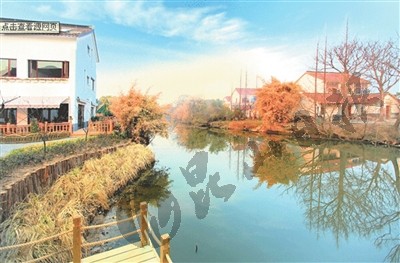Rural tourism in Kunshan
(chinadaily.com.cn)

Kunshan, endowed with rich tourism resources, is upgrading and speeding up the development of its rural tourism.
As it does so, let's quickly grasp a brief introduction to Kunshan's villages.
Zhangpu town
Jianghang village
It is located in the northwest of Zhangpu town, resembles the bagua, or the Eight Diagrams of Chinese mythology. The village on an island, has a history which stretches back to several millenniums.
It has 88-year-old Dongyue Temple, built by Taoist monks, and that makes this village a Taoist site.
Zhaoling village
As soon as you enter this village, you’ll see a bridge – Guangfu Bridge – which dates back to 1389. The granite arch bridge, measuring 17 meters in length and 2.8 meters in width, spans 5.5 meters.
However, Zhaoling is best known for the Zhaoling Mountain's Liangzhu cultural relic site, which was discovered in 1990s.
Jinxi town
Zhubang village
It is a wonderful location and preserves 20 ancient kilns.
Zhudian Ancient Kiln Site, covering an area of 120,000 square meters, still produces 17.6 million pieces of black bricks and grey tiles annually.
The Qing Dynasty (1644-1911) kiln had made it to the Jiangsu Provincial Culture Relic Protection Sites.
Zhangjiaku village
The village, with a history of over 2,000 years, also features picturesque sceneries.
Its name is to commemorate Zhang Zhao, a famous politician and high official in the State of Wu (AD 222-280), who ran away during a social upheaval and died there.
Qiandeng town
Xiemaqiao village
The village is in Kunshan's Qiandeng town, Jiangsu province, and also listed among the third batch of Chinese traditional villages, which are often referred as physical and intangible cultural heritages and are of high historic, cultural, scientific, social and economic value.
Qiandeng has invested 15 million yuan ($2.44 million) to restore Xiemaqiao and has transformed it into a beautiful village that now boasts of both scenic beauty and well-preserved culture.
It preserves stone paths, architectures from the Ming (1368-1644) and Qing (1636-1912) dynasties and pavilions, terraces and towers dating back to more ancient times.
Zhoushi town
Dongfang village
Dongfang, dating back to 1920s, is the only home village of overseas Chinese in South Jiangsu.
There exist 28 buildings built in the Republic of China (1912-1949), which covers a gross area of 3,371 square meters.
Bacheng town
Zhuodunshan village
The village is surrounded by Yangcheng and Kuilei lakes. Its history can be traced back nearly 6,500 thousand years.
Because water of Zhoudunshan lakes is not contaminated, so the village supplies potable water to all towns and villages of Kunshan.
In addition to a national culture relic protection site, it also happens to be the birthplace of Kunqu Opera.
Dianshanhu town
Liurudun village
People living in cities would appreciate the peace and tranquility in the village, which is embraced by farmland and rivers.
Huaqiao town
Tianfu village
The village, located in the north of Huaqiao International Service Business Park, has a long history and deep culture. Its Jufu Bridge, Yongqing Bridge, Wanshou Bridge and Tianfu Nunnery constitute a unique picture of history.
Legends narrate that the mother of Eastern Wu Sun Quan state's founder built 18 rooms near the presently existing Tianfu Nunnery to worship the Goddess of Mercy during the Three Kingdoms period (AD 220-280).

